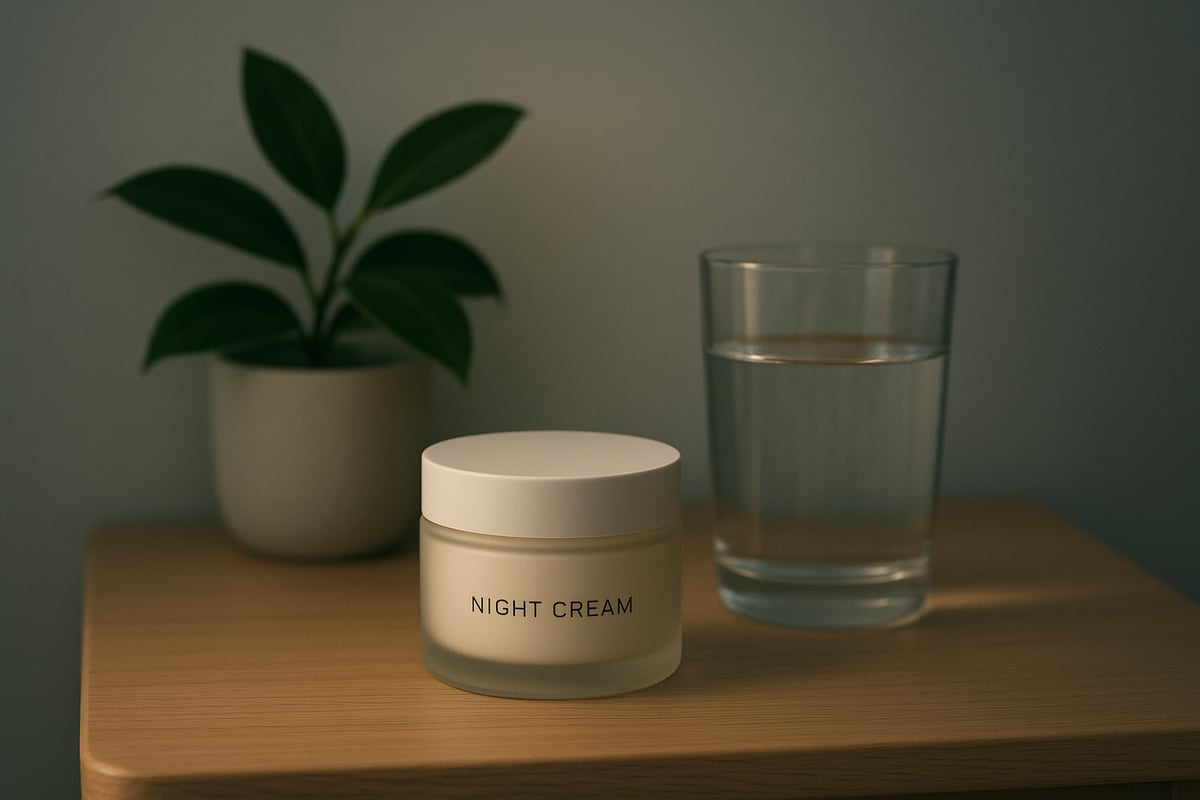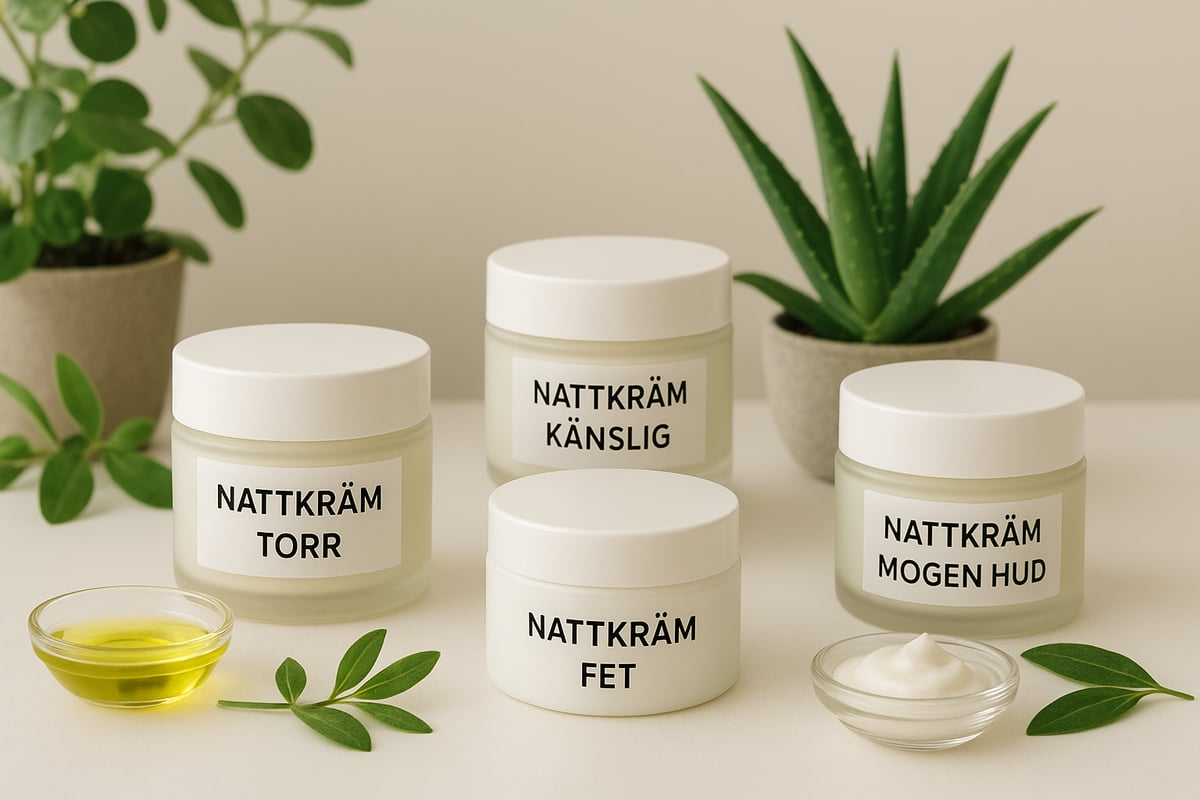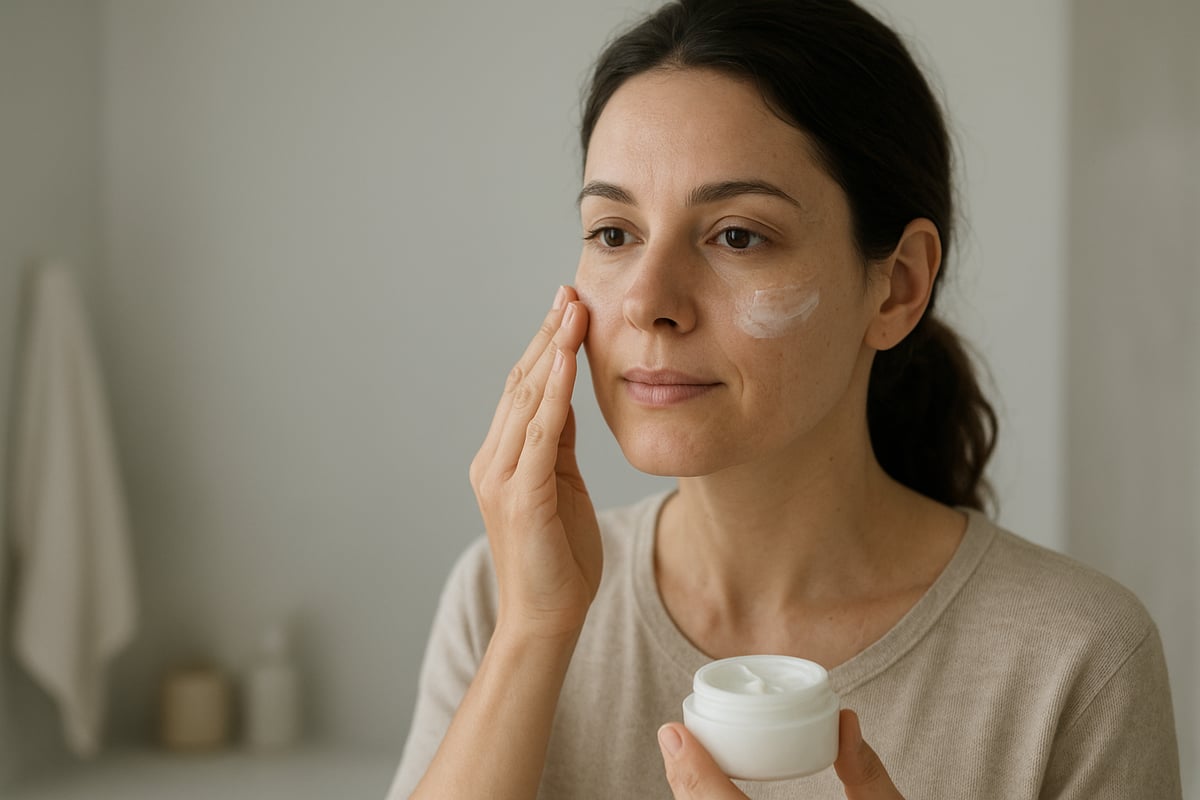Finding the right night cream has become a central part of modern skincare in 2025. During the night, the skin gets the opportunity to recover, and an effective night cream can make a big difference to the health and radiance of the skin.
This guide is designed to help you understand why night cream is crucial, how to choose the right product, and how to build the optimal nighttime routine. We review the latest science, provide concrete advice, and share expert tips to help you achieve the best possible results.
Follow along and discover new trends, smart solutions and take the step towards stronger and more healthy skin.
Why is night cream important for your skincare routine?
Understanding why night cream is a central part of your skincare routine is crucial to achieving visible and long-lasting results. During the night, your skin actively works to repair and renew itself. This is when your body's cells recover from the stresses and environmental damage of the day.

The skin's natural recovery process at night
At night, the skin enters an intense repair mode. Research shows that cell renewal can occur up to three times faster at night compared to the day (KICKS/Clarins). During sleep, blood circulation increases and the skin absorbs nutrients from night cream more easily, allowing active ingredients to work more deeply.
The skin's barrier function is also different at night. During the day, it protects against dirt, UV radiation and pollution. At night, the skin becomes more receptive to moisture and repair, but also more sensitive to dehydration. Therefore, it is important to choose a night cream that is adapted for recovery and intensive care when the skin needs it most.
Understanding this process will help you maximize the effectiveness of your skincare routine and prevent future problems.
The difference between day cream and night cream
There are clear differences between day cream and night cream. Day cream is designed to protect the skin from external stressors such as sun, pollution and stress. Night cream focuses instead on repairing, hydrating and nourishing the skin while you sleep.
| Property | Day cream | Night cream |
|---|---|---|
| Purpose | Protection | Repair & nutrition |
| Texture | Lightweight, quickly absorbed | Rich, fatter |
| Active ingredients | SPF, antioxidants | Retinol, peptides, oils |
| Usage time | Morning | Evening |
According to dermatologists, night cream is indispensable because the skin has other needs at night. The richer consistency and higher concentration of active ingredients mean that night cream can effectively work with the skin's renewal process. If you want to read more about different types of night creams and find the right one for your skin, you can visit Natural night creams for all skin types .
Common skin problems that night cream addresses
Many people experience problems such as dryness, fine lines, uneven pigmentation and loss of elasticity, especially with increasing age or during the winter months. Night cream is developed to actively counteract these problems.
The most common skin problems night cream can help with are:
- Dry and tight skin
- Visible fine lines and wrinkles
- Uneven skin tone and pigment spots
- Reduced elasticity and luster
Statistics show that 78% of users see improved skin texture after regular use of night cream (KICKS customer data). User studies with before and after photos confirm that night cream can make a big difference, especially if the product is adapted to skin type and needs.
Long-term benefits of night cream
Investing in an effective night cream will yield clear long-term results. In addition to counteracting the signs of aging, regular use contributes to a more even skin tone, increased radiance and a stronger skin barrier.
Scientific studies show that night creams with anti-aging ingredients, such as retinol and peptides, can reduce the appearance of wrinkles and improve skin texture over time. Therefore, prioritizing night cream in your routine is one of the most effective strategies for preventing future skin problems and maintaining youthful skin.
In summary, night cream is a key product that works while you sleep, strengthening your skin's natural processes and giving you the conditions for healthier, more beautiful skin in both the short and long term.
How do you choose the right night cream for your skin type?
Finding the right night cream for your unique skin type can feel like a jungle. Needs vary greatly between dry, oily, sensitive, mature or combination skin. By understanding your skin's signals and choosing a night cream tailored to you, you strengthen your skin's barrier and maximize recovery during the night.

Identify your skin type and needs
The first step to finding the right night cream is to identify your skin type. Dry skin feels tight, flakes and needs a lot of moisture. Oily skin tends to be shiny and requires lighter formulations. Combination skin has both dry and oily areas, while sensitive skin easily reacts to strong ingredients. Mature skin loses elasticity and needs extra nourishment.
According to statistics from KICKS, dry skin is the most common skin type in the Nordic countries. Choose a night cream based on these needs: Clarins and KICKS, for example, have products for each category. If you have sensitive skin, you can read more about gentle night creams and special advice in Skincare for sensitive skin .
| Skin type | Typical needs | Examples of night cream ingredients |
|---|---|---|
| Dry | Moisture, barrier support | Hyaluronic acid, ceramides |
| Fat | Balancing, mattifying | Niacinamide, lighter oils |
| Sensitive | Mild, soothing | Aloe vera, oat extract |
| Mature | Firmness, nutrition | Retinol, peptides |
Choosing the right night cream reduces the risk of imbalance and irritation.
Key ingredients to look for
Ingredients determine the effect of your night cream. Hyaluronic acid binds moisture deeply and is suitable for all skin types. Retinol stimulates cell renewal and counteracts signs of aging, but can irritate sensitive skin. Niacinamide evens out skin tone and strengthens the barrier, while ceramides protect against moisture loss.
Clarins Extra-Firming Night Cream, for example, contains [COLLAGEN]³ technology that gives the skin increased firmness. Always read the ingredients list of your night cream and be aware of any side effects, especially if you have sensitive skin or are using multiple active ingredients at the same time.
Try new night cream products gradually and observe how your skin reacts. Adjust ingredients according to season and needs.
Avoid these common mistakes
Choosing the wrong night cream can worsen skin problems. A common mistake is to use day cream at night. Day cream protects against external stressors, while night cream is designed to repair and nourish. Over-applying night cream can clog pores and cause blemishes.
Avoid changing your night cream too often, as your skin needs time to adjust. Another mistake is to ignore your skin's changes over time and season, which can lead to imbalance.
Be sure to adjust the amount and type of night cream to your skin's current condition. If you are unsure, please consult a dermatologist to avoid long-term problems.
Adapt to age and lifestyle
Skin needs change with age, which affects the choice of night cream. In your 20s, a light moisturizing night cream is often enough, while 30- and 40-year-olds may need ingredients that strengthen elasticity and prevent fine lines.
For mature skin, especially after 50, night creams with a higher proportion of nutrients, antioxidants and active ingredients are recommended. Lifestyle also plays a role: stress, sleep and diet affect the effectiveness of your night cream.
Choose a night cream that matches both your age and your daily routine. Also adjust according to the climate, as the skin often requires a richer night cream in winter.
Budget and sustainability
Night creams come in all price ranges, from 150 SEK to over 1500 SEK. The price is often determined by ingredients, research and brand. However, it is not always the most expensive that is the best, but the right night cream for your skin type and needs is most important.
More consumers are choosing sustainable and natural night cream alternatives. Organic and vegan products, often with recyclable packaging, reduce environmental impact and the risk of irritation.
Consider both your wallet and the environment when choosing a night cream. Many sustainable options are high quality and gentle on the skin.
Step-by-step: How to build the optimal evening routine in 2025
Building an optimal nighttime routine is key to maximizing the effects of your night cream and achieving healthier skin. A structured routine helps skin recover from the stresses of the day and prepares it for overnight repair. Below, we guide you through each step, from thorough cleansing to consistent use of the right products. For those who want even more in-depth guidance, there is a complete Step-by-Step Nighttime Routine to read on.

1. Cleansing – the foundation for effective night care
Cleansing is the first and most crucial step in your evening routine. During the day, dirt, sebum, makeup and impurities accumulate on your skin. If not removed, they risk clogging your pores and reducing the effectiveness of your night cream.
Double cleansing is a method where you first use an oil-based cleanser to dissolve makeup and sunscreen, followed by a water-based cleanser to remove residue and dirt. This ensures that your skin is truly cleansed without drying it out.
Examples of cleaning products:
- Milk cleanser for dry and sensitive skin
- Foaming cleanser for oily or combination skin
- Micellar water as an extra step if needed
Thorough cleansing gives the skin the best possible conditions to absorb the active ingredients in the night cream and subsequent products.
2. Exfoliation – renews the skin surface (1-2 times/week)
Exfoliation is the step that helps remove dead skin cells and stimulate cell renewal. When you exfoliate your skin 1-2 times per week, you increase the effectiveness of your night cream, as the product can penetrate the skin more easily.
There are two main types of exfoliation:
- Mechanical peeling: small grains are gently massaged over the skin
- Chemical peels: acids like AHA or BHA dissolve dead skin cells without rubbing
Warning: Avoid exfoliating too often, as this can weaken the skin barrier and lead to irritation. Adapt your exfoliation to your skin type and avoid if your skin feels red or sore.
After exfoliation, your skin often feels softer and looks healthier. This is also when your night cream really gets a chance to work deep down.
3. Serum – targeted treatments as needed
Serums are concentrated products applied after cleansing (and exfoliating) but before night cream. They are designed to target specific skin needs, such as moisture, radiance, pigmentation or signs of aging.
Common serum ingredients:
- Hyaluronic acid for deep hydration
- Retinol for anti-aging and skin renewal
- Vitamin C for radiance and more even skin tone
Apply a few drops of serum evenly over the face and allow it to absorb before continuing with your night cream. This enhances the effect of both the serum and night cream, as they work in synergy.
4. Night cream – application and technique
Night cream is the heart of your evening routine. It is usually richer and more nourishing than day cream, allowing your skin to recover maximally while you sleep. Apply a small amount of night cream to your face and neck after your serum.
Tips for best results:
- Massage the night cream in with circular movements to stimulate blood circulation and increase absorption.
- Don't forget the neck and décolleté, where the skin is thin and sensitive.
It is important not to overdo it with night cream, as too much product can clog pores. Always follow the manufacturer's recommendations for amount and technique. Many skin care brands, such as Clarins and KICKS, offer instructional videos on the correct application of night cream.
5. Extra care – masks, oils and eye cream
To complement your routine, you can add extra care a few times a week. A night mask provides intense hydration and nourishment overnight, while a facial oil is especially good for dry or mature skin.
Feel free to combine your night cream with an eye cream to care for the sensitive area around the eyes. Keep in mind that different products can be used in different combinations, depending on the skin's condition and needs.
Regularly using masks or oils in combination with night cream can give the skin an extra boost and contribute to more visible results.
6. Consistency and long-term perspective
Following your nighttime routine every day is crucial to achieving and maintaining results. Studies show that most people see clear improvement in skin texture and radiance after 4-6 weeks of consistent use of night cream.
To stay motivated, you can document your progress with before and after photos. Remember that skincare is a long-term investment, and that night cream works best when used regularly as part of a holistic routine.
Frequently Asked Questions and Myths About Night Cream 2025
Choosing the right night cream often raises many questions. Here we clear up the most common myths and misconceptions so you can make informed decisions about your skincare routine.

Do I have to use night cream if I already have day cream?
Yes, night cream and day cream have different functions, and they complement each other rather than replace each other. Day cream protects the skin from external stressors such as UV radiation and pollution, while night cream is designed to support skin recovery and renewal during the night. Dermatologists emphasize that the skin works differently at night, which makes a specific night cream crucial for optimal skin health. Skipping night cream can mean you miss out on important active ingredients that support the skin's natural repair process.
Can I use night cream during the day?
It is not optimal to use night cream during the day. Many night creams contain active ingredients, such as retinol, which can make the skin more sensitive to sunlight. In addition, night creams are often richer and can feel too heavy under makeup or in daylight. If you want to learn more about how new ingredients and multifunctional creams affect your skin care routine, you can read about Skincare Trends 2025 . Always adapt your routine to your skin's needs and the time of day.
How do I know if my night cream is working?
Signs that your night cream is working include skin feeling softer, more hydrated and more elastic in the morning. Many people notice improvement after just a few weeks of regular use. A good tip is to take before and after pictures to track your progress. If you don't see any improvement, it may be time to change products or evaluate your routine. Remember that patience and consistency are the key to visible results with night cream.
Are expensive night creams always better?
The price of a night cream doesn't always determine the effect. It's the ingredients and formulation that play the biggest role in the result. Bestsellers come in several price ranges, and there are many affordable options with high quality. For those of you looking for natural or organic choices, this Guide to Organic Skin Care can be helpful. Choose a night cream based on your skin type, needs and budget rather than the price itself.
How often should I change my night cream?
It’s wise to evaluate your night cream at least once a season, as skin’s needs change with weather, age, and lifestyle. For example, a richer night cream may be more appropriate during the winter when skin is often drier. Listen to your skin and don’t be afraid to adjust your routine as needed. Customizing your night cream for the different phases of life is an investment in long-term skin health.
Expert tips and trends in night cream 2025
Skincare is evolving rapidly, and night cream is at the center of several exciting trends in 2025. Here you will find the top innovations, expert advice and insights into the future of skincare. Want to stay ahead of the curve and optimize your routine? Let us guide you through this year's most important trends and best tips.
New technologies and innovations
Technological advances are clearly leaving their mark on the development of night cream. Formulations with COLLAGEN³ technology, peptides and adaptogens provide the skin with better support for renewal. Many products now combine niacinamide for even skin tone and hyaluronic acid for intense moisture. Statistics show that multifunctional night creams are increasing in demand, as consumers want products that provide both anti-aging, radiance and protection against external stressors.
Table: Examples of innovative ingredients in night cream
| Ingredient | Effect |
|---|---|
| COLLAGEN³ | Firmer skin |
| Niacinamide | Even skin tone |
| Peptides | Increased elasticity |
| Adaptogens | Stress reducing |
By choosing a night cream with these ingredients, you get an advanced skincare solution adapted for 2025.
Personalized skincare with AI and digital advice
Personalized skincare is hotter than ever, and AI is playing a crucial role. More people are using apps and digital tools to find the right night cream. With the help of digital skin analysis, you can get recommendations based on your skin type and current needs. KICKS and Clarins already offer digital advisory services, making it easier to create a customized evening routine.
Want to learn more about how AI and technology are revolutionizing skincare? Read more in the article Understanding Global Skincare Trends .
Multifunctional products for easy routine
A clear trend in 2025 is that night creams now often combine multiple functions. Products that moisturize, reduce fine lines and give radiance in a single step are becoming increasingly popular. This simplifies everyday life for many, as fewer products are needed. Multifunctional night creams are especially appreciated by those with an active and fast-paced life.
Examples of benefits of multifunctional night cream:
- Saves time and space in the bathroom cabinet
- Provides a more comprehensive result
- Suitable for most skin types
Choosing such a product makes your evening routine smoother and more effective.
Sustainability and transparency
Consumers are placing higher demands on sustainability when choosing night cream. Interest in organic, vegan and environmentally friendly alternatives has increased by 45 percent in the past year according to KICKS. Many brands are now investing in recyclable packaging and natural ingredients.
Want to read more about how natural ingredients and sustainability are shaping this year's beauty trends? See the article Beauty Trends 2025 .
Choosing a sustainable night cream reduces the risk of irritation and at the same time contributes to a better environment.
Experts' best advice for results
To get the most out of your night cream, it is important to follow the experts' recommendations. Always apply to thoroughly cleansed skin and use the right amount of product. Consistency is key, so try to follow your routine every night. Feel free to complement it with a healthy lifestyle: sufficient sleep, a nutritious diet and stress management strengthen the effect of night cream.
Dermatologists emphasize that night cream should be the last step in your evening routine for best results. Regular use often produces visible improvements within a few weeks.
Now that you have a clear picture of how night cream can elevate your skincare routine, you may feel ready to find the right products for your needs. We’ve covered everything from the science behind night cream to how to choose ingredients and build a sustainable routine. If you’re looking to discover natural alternatives that both nourish and brighten, Éclore’s range could be a great next step. The products are made in Europe with a focus on quality, sustainability and a sense of luxury in everyday life.


